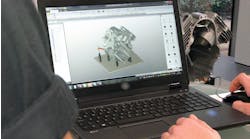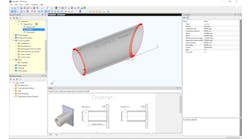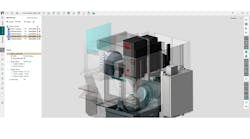Part distortion adds to the cost of machining for high-value parts, especially for large and thin-walled workpieces that are common in aerospace systems and products designed to achieve light-weight objective. The Fraunhofer Institute for Production Technology (IPT) in Aachen, Germany, coordinated a consortium of research partners to develop a system for reducing part distortion caused by residual stresses.
IPT said the model-based process plus a new type of workpiece-clamping system will help machine shops significantly reduce part distortion during milling.
During production and subsequent heat treatment of metallic blanks, residual stresses are generated that lead to shape and dimensional deviations of the workpiece during machining. Especially after unclamping, when the workpiece is released from the workholding system, significant distortion of the part may occur. Part distortion means that the manufacturing tolerances cannot be maintained, and the part has to be reworked. IPT cited a 2001 report in which Boeing estimated its annual costs for delay-related rework and scrap at about $290 million.
FEM simulation of part distortion. The "VoKoES" research team, led by Fraunhofer IPT including CAD/CAM developer ModuleWorks and workholding specialist Innoclamp, among others, developed a concept consisting of a simulation software and a new workholding system that can be used to predict and reduce part distortion during milling of rolled and heat-treated workpieces.
Using the example of an aerospace structural component made of the titanium alloy Ti‑6AI‑4V, they developed and demonstrated techniques that reduced the distortion by 94%.
With another research partner, Access e.V., they programmed a thermomechanical FEM-simulation to determine residual stress in heat-treated blanks. A numerical distortion simulation was developed that made it possible to predict the part distortion after each milling operation. IPT researchers programmed the simulation together with the Institute for Structural Mechanics and Lightweight Design (SLA) at RWTH Aachen University based on the Finite Cell Method.
Simulation integrated with CAM. With Module Works, IPT researchers integrated the simulation into a CAM system to define toolpath. Based on the part distortion prediction, the team tested various compensation methods, such as varying the machining sequence or the position of the target part within the blank. The results of the compensation methods can be displayed in the CAM program.
Because the simulation is integration into the CAM system there is no need for add-on software, and the simulation/programming process can be applied to all workpiece geometries and manufacturing processes (milling, turning, etc.)
Adaptive, hydraulic clamping. In addition to digital solutions for predicting and reducing part distortion, Innoclamp developed an adaptive, hydraulic clamping system for milling aerospace structural components. With that new system, residual stresses in the clamped workpieces can be released in a controlled manner during machining, and the “stress free” workpieces that result are available for further machining.
Thus, the designed geometries can be produced without part distortion after unclamping. Part distortion between machining steps is allowed without losing the part's references and without the need to re-measure the part.
The research team plans to expand the simulation software in follow-up projects that will go on to study workpiece and tool deflection. Also, IPT noted that the same methodology could be applied to additive manufacturing processes, where part distortions also frequently occur, though the compensation strategies must still be developed.






